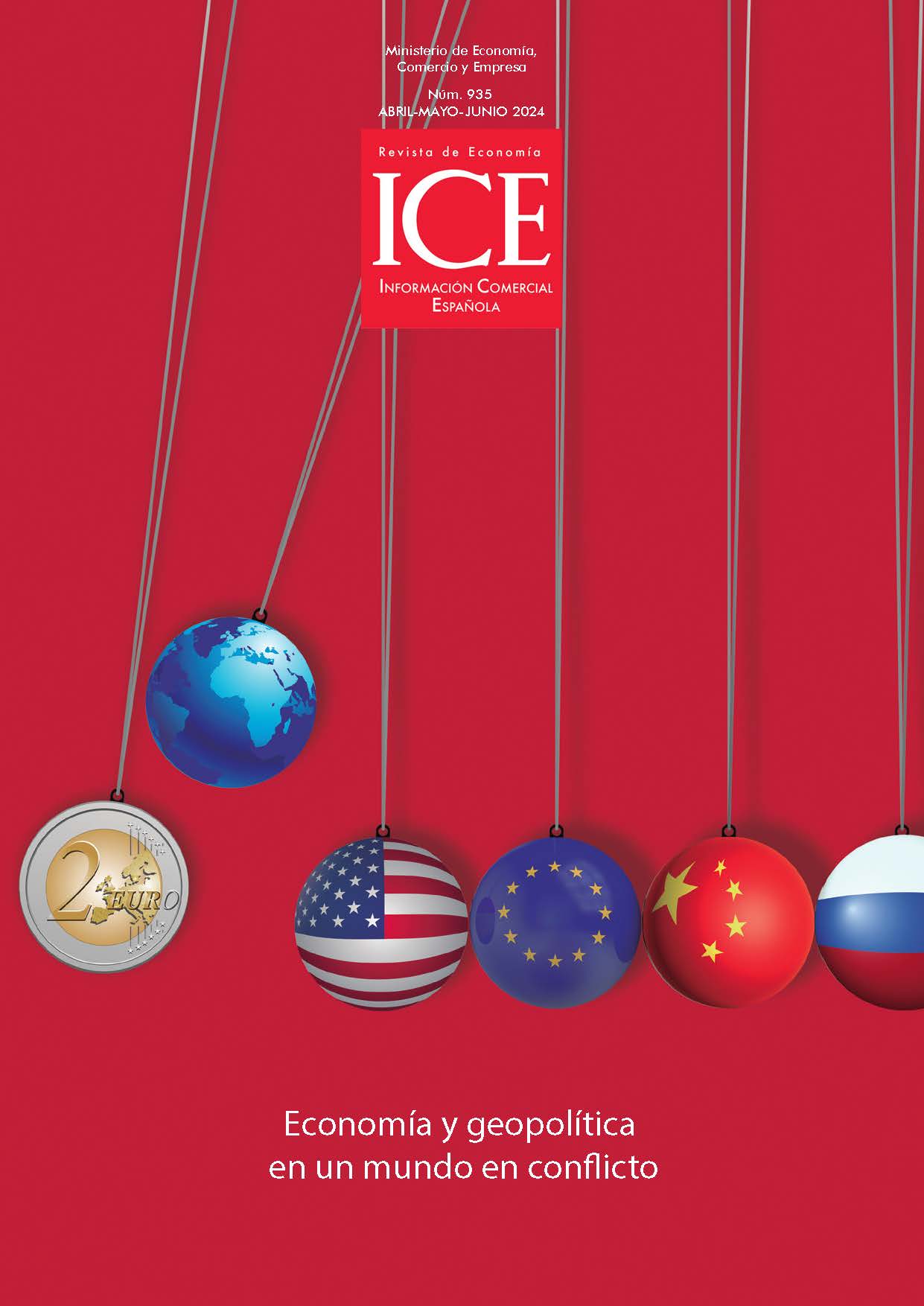Economics and Geopolitics of Energy Sector: From Fossil Fuels to Transition Minerals
##plugins.themes.bootstrap3.article.sidebar##
Downloads
##plugins.themes.bootstrap3.article.main##
This article explores how, in the current complex geopolitical landscape, economic and energy security has become a top priority. It also illustrates how the energy transition reduces dependence on fossil fuels but introduces new vulnerabilities by increasing demand for critical minerals —specially in the form of refined and purified products— reshaping geopolitical actors and dynamics. China's current dominance in these materials presents crucial challenges. In response, Western countries seek strategies to reshape supply chains and attract new investment, yet these efforts clash with the difficulty and costs of reducing dependence on China, giving rise to a series of dilemmas regarding the desire for decoupling from China and the need to advance faster in the energy transition.
##plugins.themes.bootstrap3.article.details##
- Pedro Antonio Merino García, Rebeca Albacete Sánchez-Mateos, José María Martínez Pérez, Juan Jesús Rubio Jareño, Economic recovery and Spanish foreign sector, some considerations , ICE, Revista de Economía: No. 924 (2022): La crisis de la COVID-19: el camino de la recuperación
Arezki, R., & Van der Ploeg, F. (2023). On the new geopolitics of critical materials and the green transition. In C. Gollier & D. Rohner (Eds.), Peace not Pollution: How Going Green Can Tackle Climate Change and Toxic Politics (pp. 199-211). CEPR Press. https://cepr.org/publications/books-and-reports/peace-not-pollution-how-going-green-can-tackle-climate-change-and
Bistline, J., Blanford, G., Brown, M., Burtraw, D., Domeshek, M., Jamil Farbes, J., Fawcett, A., Hamilton, A., Jenkins, J., Jones, R., King, B., Kolus, H., Larsen, J., Levin, A., Mahajan, M., Marcy, C., Mayfield, E., Mcfarland, J., Mcjeon, H., Orvis, R., Patankar, N., Rennert, K., Roney, C., Roy, N., Schivley, G., Steinberg, D., Victor, N., Wenzel, S., Weyant, J., Wiser, R., Yuan, M., & Zhao, A. (2023). Emissions and energy impacts of the Inflation Reduction Act. Science, 380(6652), 1324-1327.
BloombergNEF. (2024). China's Clean-Tech Dominance Grows Despite Onshoring Push. Bloomberg.
Boer, L., Pescatori, A., & Stuermer, M. (2021). Energy Transition Metals (IMF Working Papers No. 21/243). International Monetary Fund.
Bogmans, C., Pescatori, A., & Prifti, E. (2023). The Impact of Climate Policy on Oil and Gas Investment: Evidence from Firm-Level Data (IMF Working Paper No. 23/140). International Monetary Fund.
Calvo, G., Mudd, G., Valero, A., & Valero, A. (2016). Decreasing ore grades in global metallic mining: a theoretical issue or a global reality? Resources, 5(4), 1-14.
Chester, L. (2010). Conceptualising energy security and making explicit its polysemic nature. Energy Policy, 38(2), 887-895.
Evenett, S., Jakubik, A., Martín, F., & Ruta, M. (2024). The Return of Industrial Policy in Data (IMF Working Paper No. 2024/001). International Monetary Fund.
FMI. (2023). Geopolitics and Financial Fragmentation: Implications for Macro Financial Stability. In Global Financial Stability Report: Safeguarding Financial Stability amid High Inflation and Geopolitical Risks (pp. 81-101). International Monetary Fund.
Galbraith, J. K. (2023). The Gift of Sanctions: An Analysis of Assessments of the Russian Economy, 2022 – 2023 (Institute for New Economic Thinking Working Paper Series No. 204).
Grasso, V. B. (2013). Rare Earth Elements in National Defense: Background, Oversight Issues, and Options for Congress. CSR Report, R41744. Congressional Research Service.
IEA. (2021). The Role of Critical Minerals in Clean Energy Transitions. International Energy Agency.
IEA. (2023a). Renewables 2023. International Energy Agency.
IEA. (2023b). Total Demand for Selected Minerals by End Use in the Net Zero Scenario, 2021-2050. International Energy Agency.
IRENA. (2023). World Energy Transitions Outlook 2023: 1.5 °C Pathway, 1. International Renewable Energy Agency.
Javorcik, B., Kitzmüller, L., Mathew, S., Schweiger, H., & Wang, X. (2023). The green transition and geopolitical tensions. CEPR. https://cepr.org/voxeu/columns/green-transition-and-geopolitical-tensions
Kim, J., Panton, A., & Schwerhoff, G. (2024). Energy security and the green transition (IMF Working Paper No. 2024/006). International Monetary Fund.
McKinsey & Company. (2022). The raw-materials challenge: How the metals and mining sector will be at the core of enabling the energy transition.
Reuters. (2024, April 23). China can’t quit coal by 2040, researchers say, despite global climate goals. https://www.reuters.com/world/china/china-cant-quit-coal-by-2040-researchers-say-despite-global-climate-goals-2024-04-23/
Schmidt, T. S., Steffen, B., Egli, F., Pahle, M., Tietjen, O., & Edenhofer, O. (2019). Adverse Effects of Rising Interest Rates on Sustainable Energy Transitions. Nature Sustainability, 2(9), 879-885. https://doi.org/10.1038/s41893-019-0375-2
Sullivan, J. (16 de septiembre de 2022). Palabras del Asesor de Seguridad Nacional Jake Sullivan en la Cumbre Global de Tecnologías Emergentes del Proyecto Especial de Estudios Competitivos. https://www.whitehouse.gov/briefing-room/speeches-remarks/2022/09/16/remarks-by-national-security-advisor-jake-sullivan-at-the-special-competitive-studies-project-global-emerging-technologies-summit/
The Economist. (2023, September 11). How to avoid a green-metals crunch. The Economist.
Yergin, D. (2006). The Prize: The Epic Quest for Oil, Money, and Power. Free Press.


